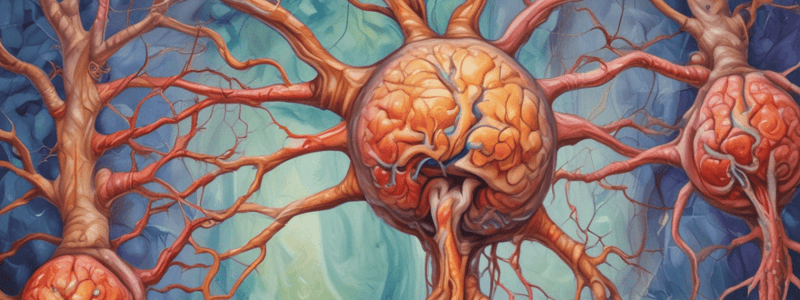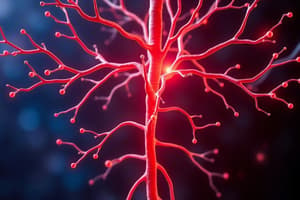Podcast
Questions and Answers
What division is also called the thoracolumbar division?
What division is also called the thoracolumbar division?
sympathetic division
Where are the cell bodies of preganglionic neurons of the parasympathetic division located?
Where are the cell bodies of preganglionic neurons of the parasympathetic division located?
- Motor nucleus in brainstem
- Lateral gray horn
- Spinal cord segments T1 - L2
- Motor nucleus in lateral gray matter (correct)
Preganglionic axons of the sympathetic division are short.
Preganglionic axons of the sympathetic division are short.
True (A)
In the sympathetic division, ___________ axons are short and postganglionic axons are long.
In the sympathetic division, ___________ axons are short and postganglionic axons are long.
What types of glands are stimulated by the sympathetic nervous system?
What types of glands are stimulated by the sympathetic nervous system?
Which organ experiences decreased secretion and motility under the influence of the sympathetic nervous system?
Which organ experiences decreased secretion and motility under the influence of the sympathetic nervous system?
Which response is induced by the parasympathetic nervous system?
Which response is induced by the parasympathetic nervous system?
The somatic nervous system controls involuntary organ functions.
The somatic nervous system controls involuntary organ functions.
The autonomic nervous system is divided into ______ and ______ divisions.
The autonomic nervous system is divided into ______ and ______ divisions.
What neurotransmitter do preganglionic neurons release in the sympathetic nervous system?
What neurotransmitter do preganglionic neurons release in the sympathetic nervous system?
What neurotransmitter do postganglionic neurons release in the parasympathetic nervous system?
What neurotransmitter do postganglionic neurons release in the parasympathetic nervous system?
Which receptors bind acetylcholine in the autonomic nervous system?
Which receptors bind acetylcholine in the autonomic nervous system?
Receptors that bind noradrenalin are called __________ receptors.
Receptors that bind noradrenalin are called __________ receptors.
Muscarinic receptors can either be excitatory or inhibitory in their effects.
Muscarinic receptors can either be excitatory or inhibitory in their effects.
List the divisions of the autonomic nervous system.
List the divisions of the autonomic nervous system.
What is the main function of the sympathetic division of the autonomic nervous system?
What is the main function of the sympathetic division of the autonomic nervous system?
What is the function of the parasympathetic division of the autonomic nervous system?
What is the function of the parasympathetic division of the autonomic nervous system?
Most effector organs are innervated by only one division of the autonomic nervous system.
Most effector organs are innervated by only one division of the autonomic nervous system.
The division of the autonomic nervous system that stimulates release of glucose into blood is the __________ division.
The division of the autonomic nervous system that stimulates release of glucose into blood is the __________ division.
What is the main function of an excitatory postsynaptic potential (EPSP)?
What is the main function of an excitatory postsynaptic potential (EPSP)?
What effect does an inhibitory postsynaptic potential (IPSP) have on a postsynaptic cell?
What effect does an inhibitory postsynaptic potential (IPSP) have on a postsynaptic cell?
What happens when a postsynaptic membrane is depolarized by an excitatory receptor?
What happens when a postsynaptic membrane is depolarized by an excitatory receptor?
Low levels of Acetylcholine are associated with Alzheimer's disease.
Low levels of Acetylcholine are associated with Alzheimer's disease.
______ is the main inhibitory neurotransmitter in the brain.
______ is the main inhibitory neurotransmitter in the brain.
Match the neurotransmitter with its function:
Match the neurotransmitter with its function:
Study Notes
Autonomic Nervous System (ANS) and Neurotransmitters
- The autonomic nervous system (ANS) is a branch of the peripheral nervous system (PNS) that controls involuntary actions, such as heart rate, digestion, and respiration.
Divisions of the ANS
- The ANS consists of two divisions: sympathetic and parasympathetic nervous systems.
- The sympathetic nervous system prepares the body for flight-or-fight responses, while the parasympathetic nervous system promotes relaxation and digestion.
Sympathetic Nervous System
- The sympathetic nervous system:
- Prepares the body for heightened activity (e.g., exercise, excitement, emergency).
- Increases heart rate and blood pressure.
- Dilates airways and increases respiratory rate.
- Decreases digestion and increases glucose release from the liver.
- Stimulates sweat glands and salivary glands.
Parasympathetic Nervous System
- The parasympathetic nervous system:
- Promotes relaxation and digestion.
- Decreases heart rate and blood pressure.
- Constricts airways and decreases respiratory rate.
- Increases digestion and glucose uptake in the liver.
- Stimulates salivary glands and promotes urination.
Comparison of Somatic and Autonomic Nervous Systems
- Both somatic and autonomic nervous systems are efferent divisions that distribute motor commands.
- Differences between the two systems include:
- Neural pathways (afferent and efferent nerves).
- Effectors (target organs).
- Organ response.
- Neurotransmitters (acetylcholine and noradrenalin).
Neurotransmitters and Receptors
- Acetylcholine (ACh) is released by preganglionic neurons in both somatic and autonomic nervous systems.
- Postganglionic neurons in the autonomic nervous system release ACh or noradrenalin (NA).
- Receptors bind ACh or NA, mediating the effects of the neurotransmitters.
Clinical Significance
- Understanding the autonomic nervous system is essential for informed clinical practice.
- Many drugs target ANS neurotransmitters and receptors, stimulating or inhibiting selected organs or body areas.
- It is crucial to understand how these drugs affect the ANS and their potential side effects.### Autonomic Nervous System (ANS)
- Divided into two divisions: Sympathetic Nervous System (SNS) and Parasympathetic Nervous System (PNS)
Sympathetic Nervous System (SNS)
- Also known as the Thoracolumbar Division
- Preganglionic neurons arise from T1-L2 spinal cord segments
- Cell bodies located in motor nuclei of lateral gray horns
- Axons exit spinal cord via spinal nerves (ventral root)
- Ganglia located close to spinal cord
- Preganglionic axon = short, Postganglionic axon = long
- Innervates:
- Head and thorax (T1-T6)
- Abdominopelvic organs (T5-L2)
- Adrenal medulla
Parasympathetic Nervous System (PNS)
- Also known as the Craniosacral Division
- Preganglionic neurons arise from brainstem and sacral region of spinal cord (S2-S4)
- Cell bodies located in motor nuclei of brainstem and lateral gray matter of sacral spinal cord
- Axons exit CNS via cranial nerves (III, VII, IX, X) and spinal nerves (ventral root)
- Ganglia located close to or within target organs
- Preganglionic axon = long, Postganglionic axon = short
- Innervates:
- Eye, lacrimal gland, nasal mucosa, salivary glands, and heart
- Pelvic organs, stomach, small intestine, large intestine, and urinary bladder
Neurotransmitters
- Sympathetic postganglionic neurons release Noradrenaline (NA)
- Parasympathetic postganglionic neurons release Acetylcholine (ACh)
- ACh binds to cholinergic receptors, NA binds to adrenergic receptors
Receptors
- Cholinergic receptors:
- Nicotinic: always excitatory, binds ACh
- Muscarinic: excitatory or inhibitory, binds ACh
- Adrenergic receptors:
- Alpha (a): excitatory or inhibitory, binds NA and Adrenaline (A)
- Beta (b): excitatory or inhibitory, binds NA and A
Neurotransmitter-Receptor Binding
-
Binding of NT to different receptors determines the response of the target organ
-
NT binding mediates the differential effects of sympathetic and parasympathetic stimulation### Postsynaptic Potentials
-
Graded potential = postsynaptic potential
-
Excitatory postsynaptic potential (EPSP):
-
NT binds receptors on postsynaptic membrane
-
Opens gated ion channels, allowing Na+ ions to enter the cell
-
Graded depolarization, making the postsynaptic cell more likely to fire
-
Overall effect: increased target activity
-
Inhibitory postsynaptic potential (IPSP):
-
NT binds receptors on postsynaptic membrane
-
Opens gated ion channels, allowing K+ ions to exit the cell
-
Graded hyperpolarization, making the postsynaptic cell less likely to fire
-
Overall effect: decreased target activity
Autonomic Nervous System (ANS)
- Sympathetic nervous system:
- Preganglionic neuron releases ACh, which binds to nicotinic cholinergic receptors, always excitatory
- Postganglionic neuron releases NA, which binds to adrenergic receptors
- Parasympathetic nervous system:
- Preganglionic neuron releases ACh, which binds to nicotinic cholinergic receptors, always excitatory
- Postganglionic neuron releases ACh, which binds to muscarinic receptors
Neurotransmitters
- Neurotransmitters (NTs) and electrical signals are the language of the nervous system
- 50+ NTs identified, some neurons make only 1 NT, most make 2 or more NTs
- NTs induce excitatory or inhibitory responses in postsynaptic membranes
- NT imbalances traditionally thought to cause neuropsychological disorders, but this theory is now questionable
Acetylcholine
- Motor control outside the CNS
- Involved in cognition, memory, and consciousness within the CNS
- Low levels found in Alzheimer's patients
Biogenic Amines
- Broadly distributed in the brain, involved in emotional behavior and regulating biological clock
- Imbalances associated with mental illness, but no consistent evidence to support this
- Drugs that enhance NT release or block reuptake associated with relief of symptoms of anxiety and depression in some people
- Includes noradrenaline, dopamine, and serotonin
- Noradrenaline: stimulates brain reward and pleasure centers, involved in reducing stress and enhancing attention
- Dopamine: stimulates brain reward and pleasure centers, high levels noted in schizophrenia, deficient in Parkinson's disease
- Serotonin: involved in mood regulation, sleep, appetite, nausea, and migraine headaches
Amino Acids
- GABA (γ-aminobutyric acid): main inhibitory NT in the brain, helps regulate sleep/wakefulness, involved in motor control
- Glutamate: involved in learning and memory, excessive release can lead to excitotoxicity and cell death
Neuropeptides
- Substance P: produced by damaged tissue, stimulates peripheral nociceptors, mediates pain transmission to the CNS
- Endorphins: includes endorphins and enkephalins, inhibits perception of pain in the CNS, natural opiates
Studying That Suits You
Use AI to generate personalized quizzes and flashcards to suit your learning preferences.
Description
This quiz assesses your understanding of the autonomic nervous system and neurotransmitters in the context of nursing and midwifery practice. Covers fundamental skills and knowledge for nursing and midwifery practice.




